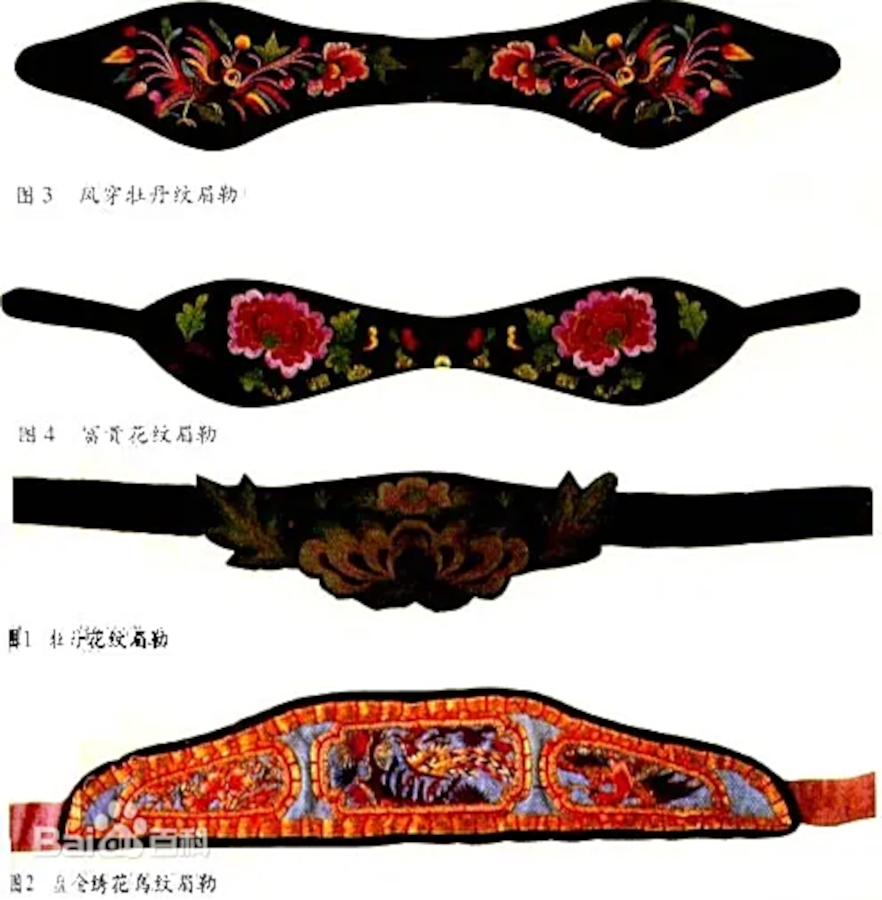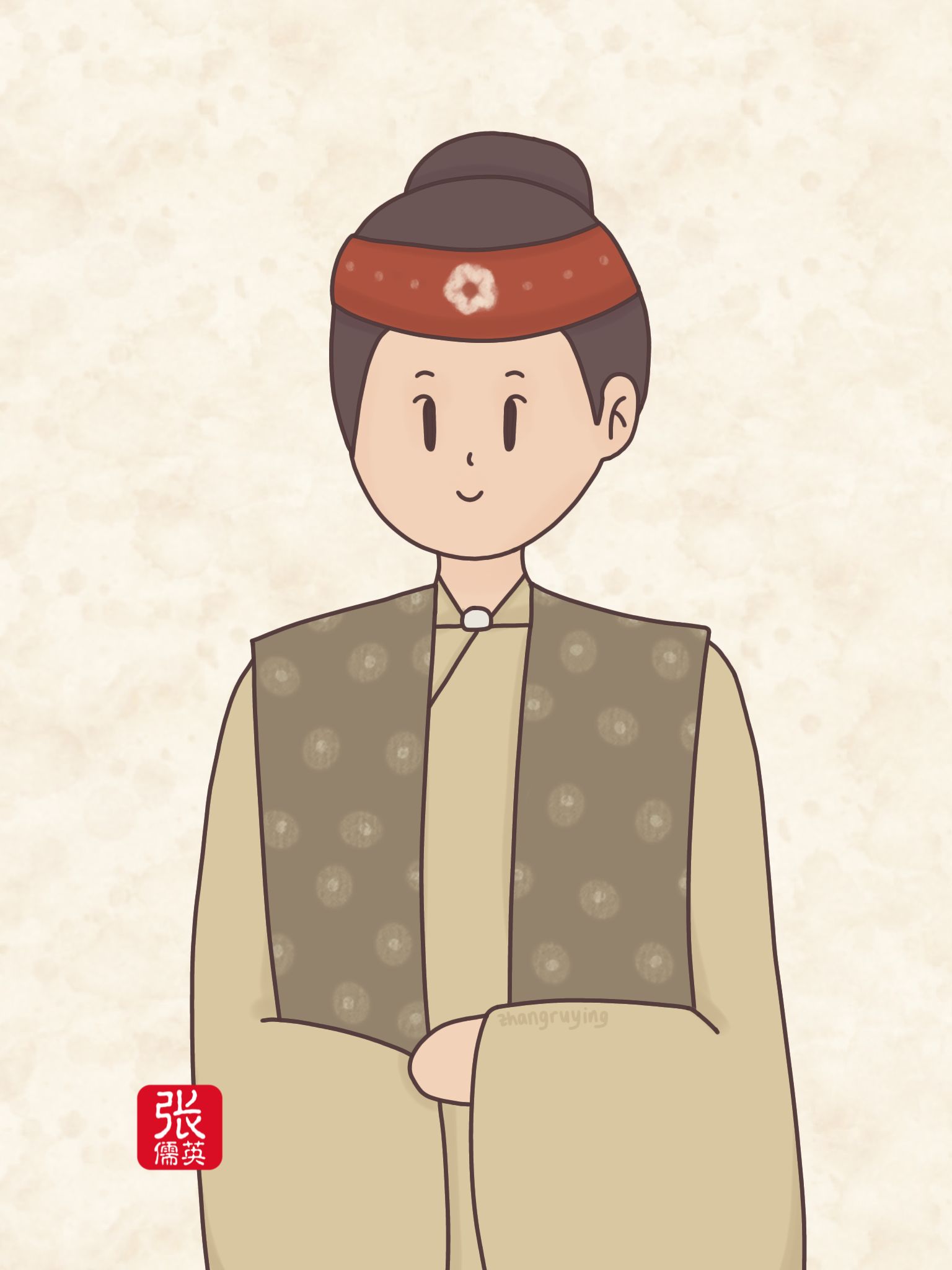Mo’e (抹额): The Chinese Forehead Ribbon
Mo’e is one type of head ornament in ancient Chinese culture, also called E Dai (额带 ; é dài), Tou Gu (头箍 ; tóu gū), Fa Gu (发箍 ; fā gū), Mei Lei (眉勒 ; méi lēi), Nao Bao (脑包 ; nǎo bāo), or Mo Tou (抹头 ; mǒ tóu). Mo’e could be made of cloth, silk, or brocade, folded or cut into a ribbon shape, then tied around the forehead. It was usually decorated with embroidery, pearls, or jade.
Mo’e (抹额 ; mǒ é) was originally a kind of head ornament created by the northern ethnic minorities in China to protect themselves from the cold. However, over time, it gradually evolved into a part of Han clothing culture, serving as a head ornament with aesthetic and symbolic value.
Origin and Development of Mo’e

Regarding the origin of Mo’e, there are two views:
- Mo’e originated from the circular head ornament of the Shang and Zhou dynasties called Kui (頍 ; kuǐ) — made of silk, worn regardless of gender or social status.
- Mo’e originated from Qiao Tou (幧头 ; qiāo tóu), also called Xiao Tou or Mo Tou, a type of headscarf popular since the Eastern Han dynasty, tied from the back right to the front and crossed at the forehead.
These two views are actually not contradictory. Kui from the Shang and Zhou periods was the earliest form of forehead decoration, and all later forehead ornaments evolved from it. In this sense, the term Mo’e refers to the custom of decorating the forehead with cloth or ribbon tied at the front of the head. However, the form of Qiao Tou from the Eastern Han period was a more direct origin of Mo’e.
Since the Qin and Han periods, Mo’e was also used in the military as an identification mark, called “Jun Rong Mo’e (军容抹额 ; jūn róng mǒ é)” — part of the military attire.
In the annotation of《续汉书·舆服志》(xù hàn shū · yú fú zhì), Hu Guang (胡广 ; Hú Guǎng) said:
“北方寒冷,以貂皮暖额,附施于冠,因遂变成首饰,此即抹额之滥觞。”
“In the cold northern regions, people used mink fur to warm their foreheads. It was first attached to hats, then evolved into a head ornament — this was the origin of Mo’e.”
Han women also wore Mo’e, especially dancers and singers. They wrapped cloth from the front to the back of the head and tied it, letting the ends hang down, and added circular ornaments on their head scarves.
The term “Mo’e 抹额” began to be used in the Tang dynasty to refer to forehead bands made from folded or sewn cloth ribbons. In《新唐书·娄师德传》(xīn táng shū · lóu shī dé chuán) it is written:
“娄师德乃自奋,戴红抹额来应诏。”
“Lou Shide, with great spirit, wore a red Mo’e to answer the emperor’s summons.”
Murals from Tang tombs show that women also wore Mo’e, especially maids or performers dressed as men. In the tomb of Princess Xincheng in Liquan, Shaanxi, there is a mural of a maid wearing a red forehead ribbon with white floral patterns. In the tomb of Consort Wei (韦贵妃 ; Wéi guìfēi), there is a painting of a maid dressed in men’s clothing wearing a long white Mo’e.
In the tomb of Duan Lanbi, a young maid in men’s attire wears a floral-patterned Mo’e. From these findings, it is known that Tang Mo’e were usually red or yellow in color, had simple designs, and featured minimal embroidery.
During the Song dynasty, soldiers still wore Mo’e over their Futou (幞头 ; fú tóu) or hats as a color identifier.
In《东京梦华录》(dōng jīng mèng huá lù) volume 10, it is recorded:
“兵士皆小帽,黄绣抹额,黄乡宽衫”
“The soldiers wore small hats, yellow embroidered Mo’e, and wide yellow robes.”
However, since Song men preferred to wear headscarves, Mo’e gradually became a women’s accessory. Song women made them more elaborate, using colorful silk, embroidering floral patterns, or adding gemstones and pearls.
During the Yuan dynasty, noblewomen rarely wore Mo’e, but women of the middle and lower classes loved to use it to keep their hair buns neat while working. The design was simple — a handkerchief folded into a band, tied from back to front around the forehead.
During the Ming and Qing dynasties, Mo’e became very popular. All women, from nobles to commoners, wore it. In addition to the fabric ribbon type, many variations appeared: embroidered ones, jewel-adorned ones, and even those with metal buckles at the ends. Wealthy families made Mo’e from otter, fox, or sable fur — soft furry bands circling the forehead, called Wo Tu (卧兔 wò tù, “lying rabbit”).
Noblewomen of the Qing dynasty who wore court attire had to wear Jin Yue (金约 ; jīn yuē) under their ceremonial crown — a circular hair clasp engraved with golden cloud patterns and inlaid with jewels — the highest form of Mo’e at that time.
Production Techniques and Shapes
The length of Mo’e generally ranged from 41–49 cm, and the width from 2.5–11 cm.
The shapes can be divided into four types:
- Spindle-shaped, with equal width or a wider center.
- Wavy shape, with upturned ends.
- Dumbbell-shaped, narrow in the middle and wider, tapering at the ends.
- “Figure-eight” shape, narrow in the center and wider at the sides.
Northern Mo’e were often shaped like birds or arrow leaves and embroidered with flowers, while those from Jiangnan were usually black, soft, and elegant.
Historical Value
The main function of Mo’e at first was to tie up hair and prevent it from obstructing the eyes during work. In winter, it also served as a head warmer. In the military, the junrong mo’e helped soldiers tighten their hats. However, over time, its practical use gave way to aesthetic value. The diverse patterns and motifs of Mo’e reflect the rich artistic sensibility and cultural taste of traditional Chinese folk art.

